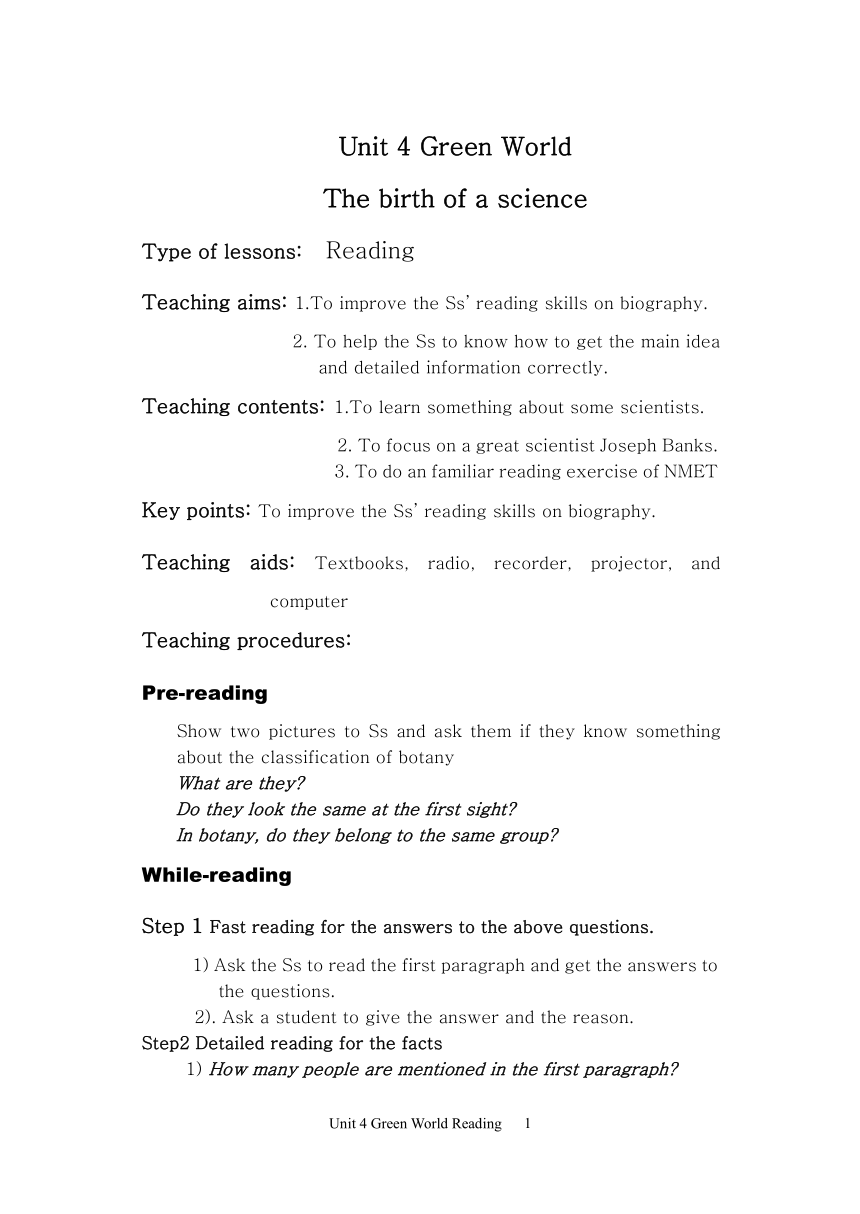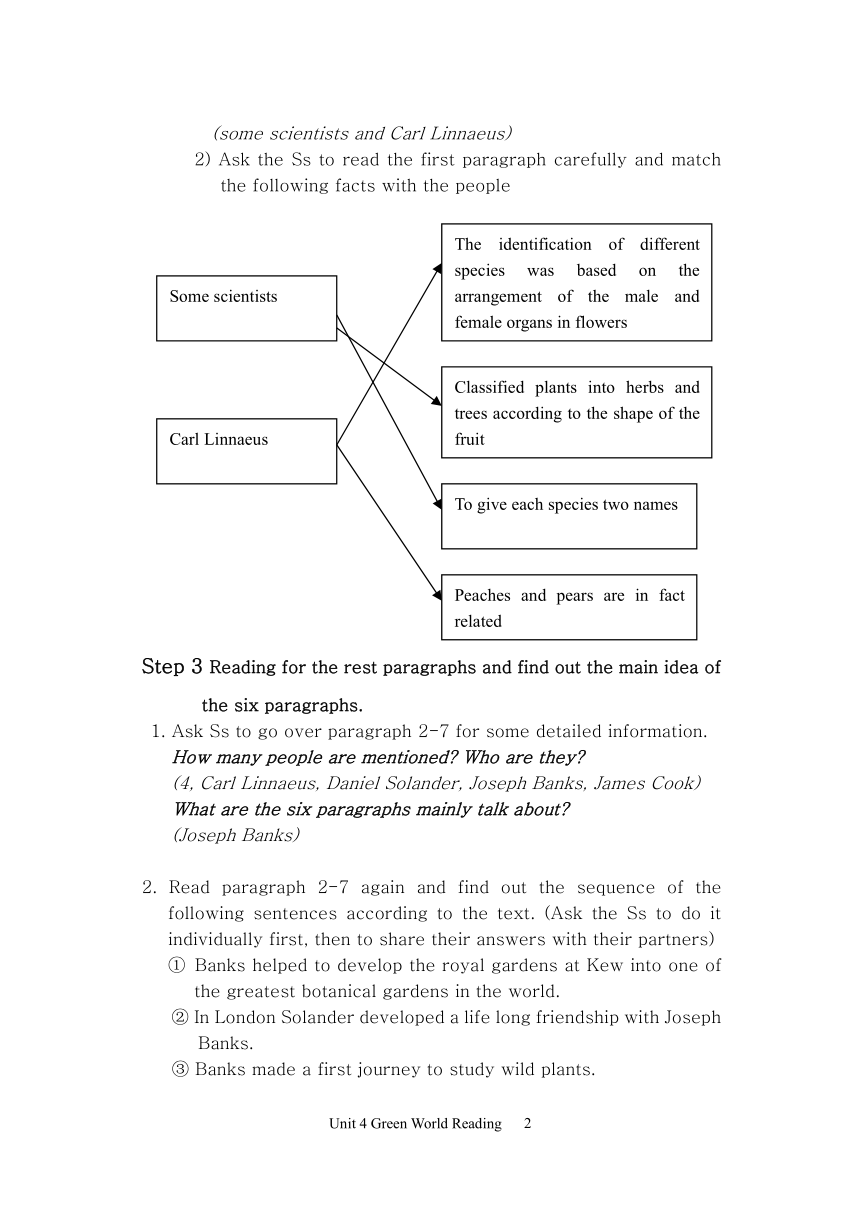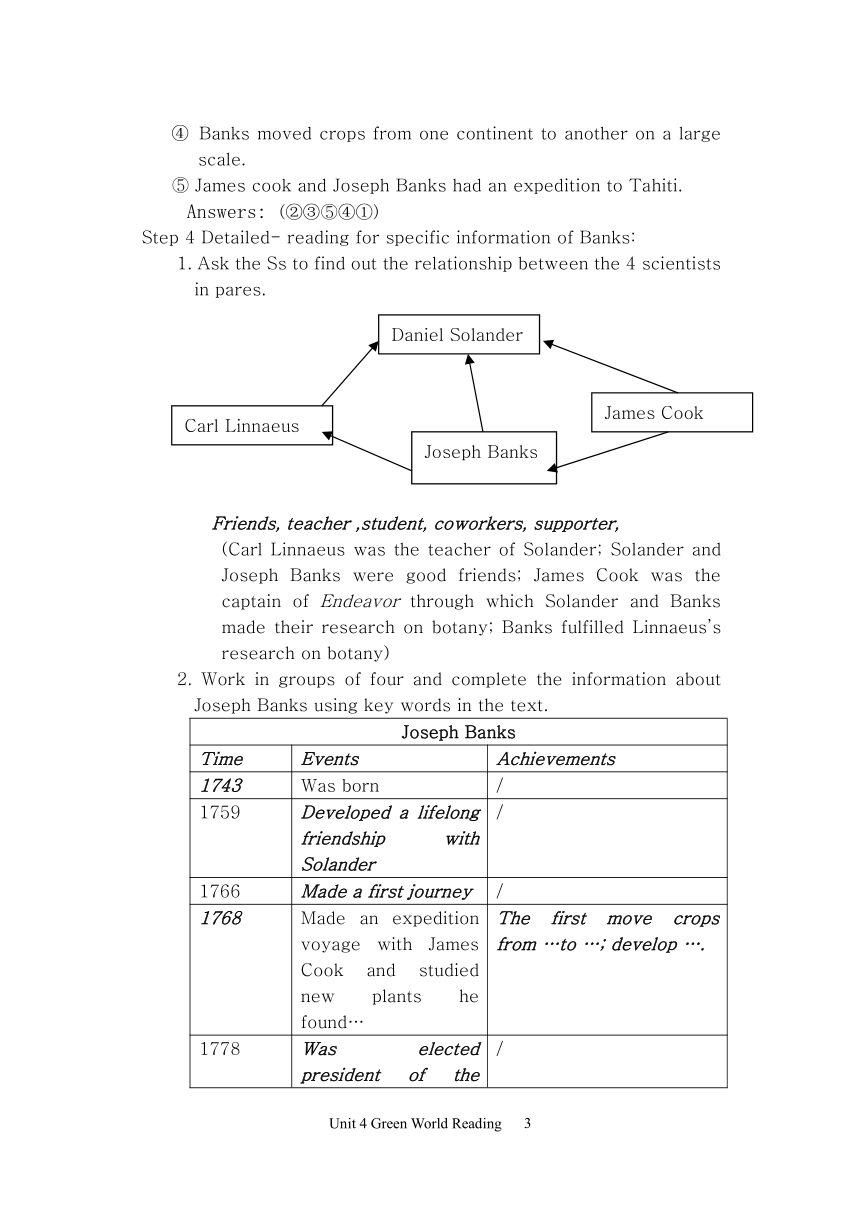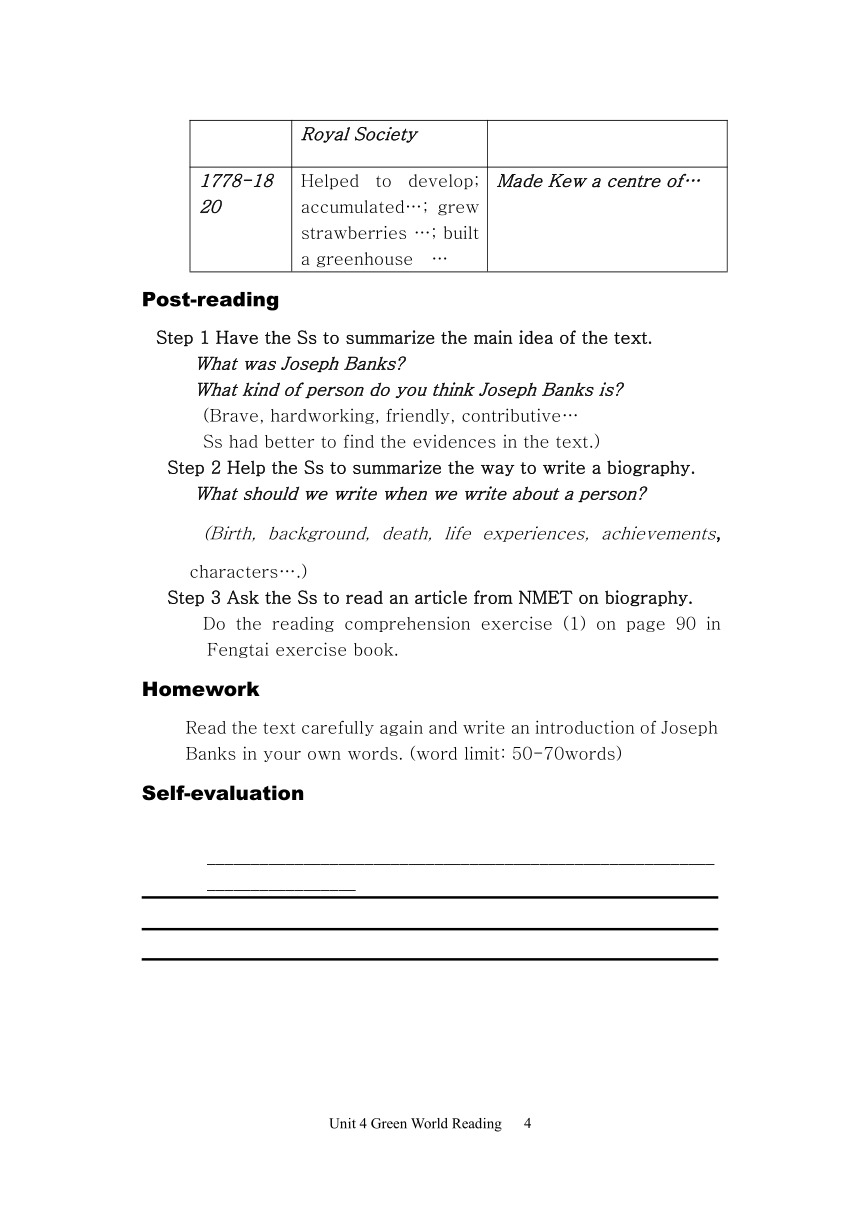unit 4 reading[下学期]
文档属性
| 名称 | unit 4 reading[下学期] |

|
|
| 格式 | rar | ||
| 文件大小 | 15.0KB | ||
| 资源类型 | 教案 | ||
| 版本资源 | 人教版(新课程标准) | ||
| 科目 | 英语 | ||
| 更新时间 | 2006-02-09 09:54:00 | ||
图片预览




文档简介
Unit 4 Green World
The birth of a science
Type of lessons: Reading
Teaching aims: 1.To improve the Ss’ reading skills on biography.
2. To help the Ss to know how to get the main idea and detailed information correctly.
Teaching contents: 1.To learn something about some scientists.
2. To focus on a great scientist Joseph Banks.
3. To do an familiar reading exercise of NMET
Key points: To improve the Ss’ reading skills on biography.
Teaching aids: Textbooks, radio, recorder, projector, and computer
Teaching procedures:
Pre-reading
Show two pictures to Ss and ask them if they know something about the classification of botany
What are they
Do they look the same at the first sight
In botany, do they belong to the same group
While-reading
Step 1 Fast reading for the answers to the above questions.
1) Ask the Ss to read the first paragraph and get the answers to
the questions.
2). Ask a student to give the answer and the reason.
Step2 Detailed reading for the facts
1) How many people are mentioned in the first paragraph
(some scientists and Carl Linnaeus)
2) Ask the Ss to read the first paragraph carefully and match the following facts with the people
Step 3 Reading for the rest paragraphs and find out the main idea of the six paragraphs.
1. Ask Ss to go over paragraph 2-7 for some detailed information.
How many people are mentioned Who are they
(4, Carl Linnaeus, Daniel Solander, Joseph Banks, James Cook)
What are the six paragraphs mainly talk about
(Joseph Banks)
2. Read paragraph 2-7 again and find out the sequence of the following sentences according to the text. (Ask the Ss to do it individually first, then to share their answers with their partners)
① Banks helped to develop the royal gardens at Kew into one of the greatest botanical gardens in the world.
② In London Solander developed a life long friendship with Joseph Banks.
③ Banks made a first journey to study wild plants.
④ Banks moved crops from one continent to another on a large scale.
⑤ James cook and Joseph Banks had an expedition to Tahiti.
Answers: (②③⑤④①)
Step 4 Detailed- reading for specific information of Banks:
1. Ask the Ss to find out the relationship between the 4 scientists in pares.
Friends, teacher ,student, coworkers, supporter,
(Carl Linnaeus was the teacher of Solander; Solander and Joseph Banks were good friends; James Cook was the captain of Endeavor through which Solander and Banks made their research on botany; Banks fulfilled Linnaeus’s research on botany)
2. Work in groups of four and complete the information about Joseph Banks using key words in the text.
Joseph Banks
Time Events Achievements
1743 Was born /
1759 Developed a lifelong friendship with Solander /
1766 Made a first journey /
1768 Made an expedition voyage with James Cook and studied new plants he found… The first move crops from …to …; develop ….
1778 Was elected president of the Royal Society /
1778-1820 Helped to develop; accumulated…; grew strawberries …; built a greenhouse … Made Kew a centre of…
Post-reading
Step 1 Have the Ss to summarize the main idea of the text.
What was Joseph Banks
What kind of person do you think Joseph Banks is
(Brave, hardworking, friendly, contributive…
Ss had better to find the evidences in the text.)
Step 2 Help the Ss to summarize the way to write a biography.
What should we write when we write about a person
(Birth, background, death, life experiences, achievements, characters….)
Step 3 Ask the Ss to read an article from NMET on biography.
Do the reading comprehension exercise (1) on page 90 in Fengtai exercise book.
Homework
Read the text carefully again and write an introduction of Joseph
Banks in your own words. (word limit: 50-70words)
Self-evaluation
___________________________________________________________________________
Unit 4 The birth of a science
1. Read the first paragraph again and match the following people with facts。
2. Read paragraph 2-7 again and rearrange the following sentences in correct order according to the text.
① Banks helped to develop the royal gardens at Kew into one of the greatest botanical gardens in the world.
② In London Solander developed a life long friendship with Joseph Banks.
③ Banks made a first journey to study wild plants.
④ Banks moved crops from one continent to another on a large scale.
⑤ James cook and Joseph Banks had an expedition to Tahiti.
Answers:
3. Discuss with your partners and find out the relationship between the 4 scientists.
You can choose from the below:
Friends, teacher and student, coworkers, supporter,
4. Work in groups of four and fill the information about Joseph Banks in the chant.
Joseph Banks
Time Events Achievements
Was born /
1759 /
1766 /
Made an expedition voyage with James Cook and studied new plants he found…
1778 /
Helped to develop; accumulated…; grew strawberries …; built a greenhouse …
Reading comprehension
Louis Pasteur, the famous French chemist and bacteriologist, invented “pasteurization”. In 1854 Pasteur was made head of the department of science at the University of Lille, and it was there that he made one of his most famous discoveries. Lille was a major centre for wine and beer-making, and some of the local wine-makers asked Pasteur if he could help solve the problem of keeping wine fresh. At that time, it was believed that food and drinks go “bad” due to a purely chemical process (变化过程). But during a series of experiments Pasteur proved that tiny living organisms (微生物) caused food and drinks to go bad. In the case of wine and beer the organisms are already present in the form of the various yeasts (酵母) that caused the fermentation (发酵) process. Pasteur discovered that heating the wine gently for a few minutes after it had fermented would kill off the yeast that was left in the wine, with the result that the wine would remain fresh for much longer. He also proved that food and drinks could be turned bad by other organisms that were present in the air, and that they too would keep fresh much longer if they were kept in airtight containers.
The heating process was so successful that it made Pasteur famous. It was named “pasteurization” in his honor, and by about 1900 it had been widely used for processing and bottling cows’ milk. The result was a huge drop in the number of bottle-fed babies dying from infant diarrhea (婴儿腹泻) and from that time on it has been a standard treatment for milk and many other food products. This simple process has saved thousands, possibly millions, of lives worldwide.
1. Pasteur became _________ in 1854.
A. the chairperson of the science department at the University of Lille
B. the director of a chemical library at the University of Lille
C. the general manager of a large beer-making company
D. the president of the University of Lille
2. According to the passage, Lille was a major centre for ______ in the mid-19th century.
A. growing grain crops
B. making beer and wine
C. doing chemical research
D. producing various kinds of yeasts
3. In the last sentence of paragraph 1, the underlined word “they” refers to ______
A. wine and beer B. food and drinks
C. the various yeasts D. other organisms
4. we can infer from the passage that Pasteur’s discovery ______
A. is no longer widely used for treating milk and other food products
B. did not bring much profit to the wine makers in Lille
C. has done a lot of good to childcare in the world
D. has greatly reduced the number of wars in the world
Homework
Read the text carefully again and write an introduction of Joseph
Banks in your own words. (Word limit: 50-70words)
Peaches and pears are in fact related
The identification of different species was based on the arrangement of the male and female organs in flowers
To give each species two names
Classified plants into herbs and trees according to the shape of the fruit
The identification of different species was based on the arrangement of the male and female organs in flowers
Some scientists
Carl Linnaeus
Peaches and pears are in fact related
James Cook
Daniel Solander
Joseph Banks
Carl Linnaeus
Classified plants into herbs and trees according to the shape of the fruit
To give each species two names
James Cook
Daniel Solander
Joseph Banks
James Cook
Carl Linnaeus
( )
( )
( )
( )
Unit 4 Green World Reading 8
The birth of a science
Type of lessons: Reading
Teaching aims: 1.To improve the Ss’ reading skills on biography.
2. To help the Ss to know how to get the main idea and detailed information correctly.
Teaching contents: 1.To learn something about some scientists.
2. To focus on a great scientist Joseph Banks.
3. To do an familiar reading exercise of NMET
Key points: To improve the Ss’ reading skills on biography.
Teaching aids: Textbooks, radio, recorder, projector, and computer
Teaching procedures:
Pre-reading
Show two pictures to Ss and ask them if they know something about the classification of botany
What are they
Do they look the same at the first sight
In botany, do they belong to the same group
While-reading
Step 1 Fast reading for the answers to the above questions.
1) Ask the Ss to read the first paragraph and get the answers to
the questions.
2). Ask a student to give the answer and the reason.
Step2 Detailed reading for the facts
1) How many people are mentioned in the first paragraph
(some scientists and Carl Linnaeus)
2) Ask the Ss to read the first paragraph carefully and match the following facts with the people
Step 3 Reading for the rest paragraphs and find out the main idea of the six paragraphs.
1. Ask Ss to go over paragraph 2-7 for some detailed information.
How many people are mentioned Who are they
(4, Carl Linnaeus, Daniel Solander, Joseph Banks, James Cook)
What are the six paragraphs mainly talk about
(Joseph Banks)
2. Read paragraph 2-7 again and find out the sequence of the following sentences according to the text. (Ask the Ss to do it individually first, then to share their answers with their partners)
① Banks helped to develop the royal gardens at Kew into one of the greatest botanical gardens in the world.
② In London Solander developed a life long friendship with Joseph Banks.
③ Banks made a first journey to study wild plants.
④ Banks moved crops from one continent to another on a large scale.
⑤ James cook and Joseph Banks had an expedition to Tahiti.
Answers: (②③⑤④①)
Step 4 Detailed- reading for specific information of Banks:
1. Ask the Ss to find out the relationship between the 4 scientists in pares.
Friends, teacher ,student, coworkers, supporter,
(Carl Linnaeus was the teacher of Solander; Solander and Joseph Banks were good friends; James Cook was the captain of Endeavor through which Solander and Banks made their research on botany; Banks fulfilled Linnaeus’s research on botany)
2. Work in groups of four and complete the information about Joseph Banks using key words in the text.
Joseph Banks
Time Events Achievements
1743 Was born /
1759 Developed a lifelong friendship with Solander /
1766 Made a first journey /
1768 Made an expedition voyage with James Cook and studied new plants he found… The first move crops from …to …; develop ….
1778 Was elected president of the Royal Society /
1778-1820 Helped to develop; accumulated…; grew strawberries …; built a greenhouse … Made Kew a centre of…
Post-reading
Step 1 Have the Ss to summarize the main idea of the text.
What was Joseph Banks
What kind of person do you think Joseph Banks is
(Brave, hardworking, friendly, contributive…
Ss had better to find the evidences in the text.)
Step 2 Help the Ss to summarize the way to write a biography.
What should we write when we write about a person
(Birth, background, death, life experiences, achievements, characters….)
Step 3 Ask the Ss to read an article from NMET on biography.
Do the reading comprehension exercise (1) on page 90 in Fengtai exercise book.
Homework
Read the text carefully again and write an introduction of Joseph
Banks in your own words. (word limit: 50-70words)
Self-evaluation
___________________________________________________________________________
Unit 4 The birth of a science
1. Read the first paragraph again and match the following people with facts。
2. Read paragraph 2-7 again and rearrange the following sentences in correct order according to the text.
① Banks helped to develop the royal gardens at Kew into one of the greatest botanical gardens in the world.
② In London Solander developed a life long friendship with Joseph Banks.
③ Banks made a first journey to study wild plants.
④ Banks moved crops from one continent to another on a large scale.
⑤ James cook and Joseph Banks had an expedition to Tahiti.
Answers:
3. Discuss with your partners and find out the relationship between the 4 scientists.
You can choose from the below:
Friends, teacher and student, coworkers, supporter,
4. Work in groups of four and fill the information about Joseph Banks in the chant.
Joseph Banks
Time Events Achievements
Was born /
1759 /
1766 /
Made an expedition voyage with James Cook and studied new plants he found…
1778 /
Helped to develop; accumulated…; grew strawberries …; built a greenhouse …
Reading comprehension
Louis Pasteur, the famous French chemist and bacteriologist, invented “pasteurization”. In 1854 Pasteur was made head of the department of science at the University of Lille, and it was there that he made one of his most famous discoveries. Lille was a major centre for wine and beer-making, and some of the local wine-makers asked Pasteur if he could help solve the problem of keeping wine fresh. At that time, it was believed that food and drinks go “bad” due to a purely chemical process (变化过程). But during a series of experiments Pasteur proved that tiny living organisms (微生物) caused food and drinks to go bad. In the case of wine and beer the organisms are already present in the form of the various yeasts (酵母) that caused the fermentation (发酵) process. Pasteur discovered that heating the wine gently for a few minutes after it had fermented would kill off the yeast that was left in the wine, with the result that the wine would remain fresh for much longer. He also proved that food and drinks could be turned bad by other organisms that were present in the air, and that they too would keep fresh much longer if they were kept in airtight containers.
The heating process was so successful that it made Pasteur famous. It was named “pasteurization” in his honor, and by about 1900 it had been widely used for processing and bottling cows’ milk. The result was a huge drop in the number of bottle-fed babies dying from infant diarrhea (婴儿腹泻) and from that time on it has been a standard treatment for milk and many other food products. This simple process has saved thousands, possibly millions, of lives worldwide.
1. Pasteur became _________ in 1854.
A. the chairperson of the science department at the University of Lille
B. the director of a chemical library at the University of Lille
C. the general manager of a large beer-making company
D. the president of the University of Lille
2. According to the passage, Lille was a major centre for ______ in the mid-19th century.
A. growing grain crops
B. making beer and wine
C. doing chemical research
D. producing various kinds of yeasts
3. In the last sentence of paragraph 1, the underlined word “they” refers to ______
A. wine and beer B. food and drinks
C. the various yeasts D. other organisms
4. we can infer from the passage that Pasteur’s discovery ______
A. is no longer widely used for treating milk and other food products
B. did not bring much profit to the wine makers in Lille
C. has done a lot of good to childcare in the world
D. has greatly reduced the number of wars in the world
Homework
Read the text carefully again and write an introduction of Joseph
Banks in your own words. (Word limit: 50-70words)
Peaches and pears are in fact related
The identification of different species was based on the arrangement of the male and female organs in flowers
To give each species two names
Classified plants into herbs and trees according to the shape of the fruit
The identification of different species was based on the arrangement of the male and female organs in flowers
Some scientists
Carl Linnaeus
Peaches and pears are in fact related
James Cook
Daniel Solander
Joseph Banks
Carl Linnaeus
Classified plants into herbs and trees according to the shape of the fruit
To give each species two names
James Cook
Daniel Solander
Joseph Banks
James Cook
Carl Linnaeus
( )
( )
( )
( )
Unit 4 Green World Reading 8
